Hokkaido is Japan’s northernmost region, separated from Honshu (the long, sausage-like island that makes up most of the country) by the Tsugaru Strait. This small stretch of ocean has meant that the region’s flora, fauna and geography has evolved quite differently to that of mainland Japan’s.
A Local’s Guide to Using Public Transport in Hokkaido
Travel Tips
By Hattie

In this wild northern land, brown bears roam vast mountain ranges, rolling hills burst with colourful flower meadows and icy coastlines are where drift ice washes ashore– all sights unique to the region. For this reason, Hokkaido has become a magnet in recent years for adventure travellers.
Hokkaido is much larger than any other prefecture in Japan and you may have heard or been told that much of the region is only accessible by rental car. While traveling by car is a popular option, it is much easier than you might imagine to get around by public transport in Hokkaido!
In this guide, I will share all you need to know about using Hokkaido’s public transport, specifically how to ride the train in Hokkaido, how to ride the bus in Hokkaido and how to catch a ferry in Hokkaido.
Why use Public Transport in Hokkaido? #

As we explored in this blog, there are many ways to travel around Hokkaido. So, why choose public transport?
The first and possibly most compelling argument is that Hokkaido is enormous. Although it is true that having a rental car gives you greater flexibility, Hokkaido is so big that there is often little difference in the time it takes to drive somewhere versus taking public transport. To give you an example, taking the train from Sapporo to Shiretoko-Shari, takes around seven hours, including the time it takes for changes at stations. If you were to drive directly from Sapporo to Shari, the journey would take you six hours– but that is without breaks! By the time breaks, toilet stops and meals are factored in, there is little different between the two journey times.
Plus, public transport is better for the planet and allows you to relax and enjoy the view instead of focusing on the road! No need to take breaks when you can nap on the train whenever you like.
Cost-wise, there is also not too much of a difference. The price of a train ticket is often comparable to that of a full tank in your car.
With these positives in mind, let’s explore the types of public transport you are most likely to use during a trip to Hokkaido.
Trains #
Train remains a popular and easy way to traverse long distances across Hokkaido. To the uninitiated it may seem scary to board a train in the middle of rural Hokkaido where English information is scarce– but you will find soon enough that you can master the train system easily. Plus, your bravery will be rewarded with some breathtaking scenery!
There are many types of train that can be found in Hokkaido and all of them have different ticket requirements. You may also find that some train lines only have one or two types of train in operation.
In some rural areas of Hokkaido, train stations may even be unmanned so it is important to know what is expected of you as the rider. Stick with me as I talk you through it!
Types of Trains #
Local Trains (“Futsuu-Ressha” 普通列車)
Example: JR Furano Line

These are small, local trains that trundle through Hokkaido’s countryside. As cars take over as the preferred method of transport in the region, these trains are being used less and less so they may only be one or two carriages with a single driver. In Japanese, these are called “wan-man ressha”– “One-Man Trains”!
These are the slowest trains, stopping at every station and struggling to keep up with cars– but the pay off is that they do allow you some of the most scenic train journeys in Hokkaido. Don’t be surprised if you meet with train enthusiasts on these routes– oftentimes they will have deliberately chosen to take these leisurely journeys over a speedy limited express, simply to enjoy the view.
Rapid Trains (“Kyuukou-Ressha” or “Kaisoku-Ressha” 急行列車 / 快速列車)
Example: The Rapid Airport service between New Chitose Airport and Sapporo (or Otaru).
These trains travel at similar speeds to local trains, but stop at less stations by comparison, making them faster. They are commonly used by commuters around Hokkaido’s more densely-populated areas like Sapporo. While they are faster than local trains, they have less carriages and smaller carriages than limited express trains.
While not all, some rapid trains do have reserved seat carriages, so in that event, you can also purchase an extra seat reservation ticket. Otherwise your standard “fare” ticket is all you need to ride rapid trains.
Limited Express Trains (“Tokkyu-Ressha” 特急列車)
Example: The Lilac Express between Sapporo and Asahikawa
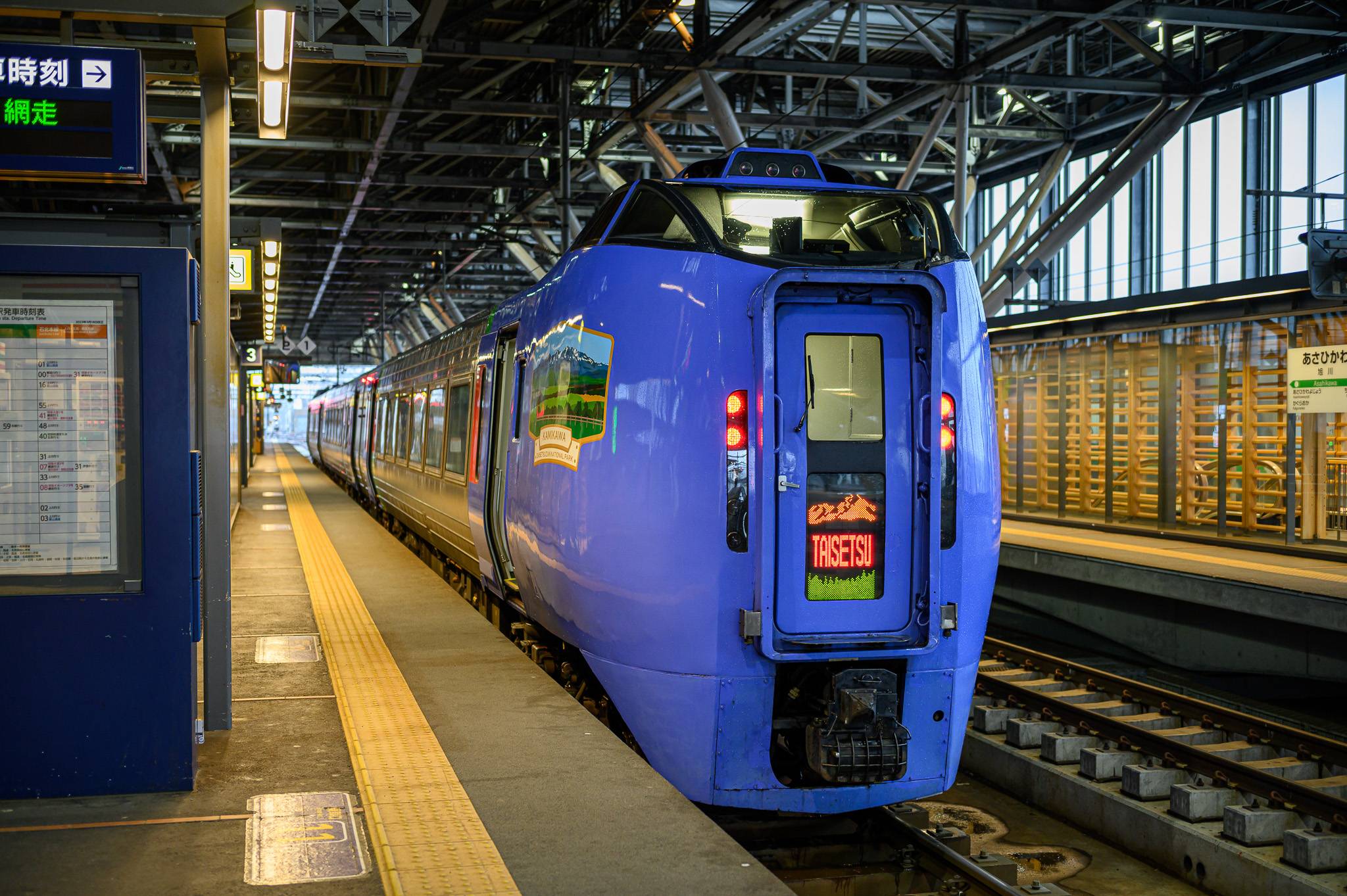
These are multi-carriage trains that travel long distances and link large cities. They are the fastest trains on the line and only stop at a limited number of stations (hence their English name, “limited express”). This means that they reach their destinations in a matter of hours.
In addition to a “fare ticket”, the fee to use the train line, you will also need a “limited express” ticket which will be checked once onboard the train Keep reading to find out how to purchase this ticket.
Unlike rapid and local trains, limited express trains also have reserved seating carriages, so you can reserve a specific seat for yourself if you wish. If you do opt for this, note that you may only sit in your assigned seat and it is a little more expensive than riding in the unreserved seating carriage. However, unreserved seating carriages are often full and when that happens, you can be left standing for some, most or all of a multi-hour journey! So for your comfort, I recommend opting for a reserved seat ticket.
Limited express trains sometimes have “Green Car” carriages too, the equivalent of first class. This of course comes with a premium, and you cannot ride in the Green Car without a Green Car ticket.
Bullet Train (“Shinkansen” 新幹線)
Example: The new Hokkaido Shinkansen, as far as Shin-Hakodate Hokuto

You may have seen the news about the brand new Hokkaido Shinkansen. In truth, this line is still very new and only goes as far as Hakodate. It is slated to reach Sapporo by 2030, but that is of course a long way off!
While you can’t use the bullet train to travel within Hokkaido, if you are looking for a novel way to get back to mainland Japan then the Hokkaido Shinkansen does run all the way from Hakodate to Tokyo. The ticket purchase process is quite similar to that of a limited express.
Subways, Trams and Scenic Trains
Example: Sapporo Municipal Subway, Hakodate City Tram, special seasonal trains
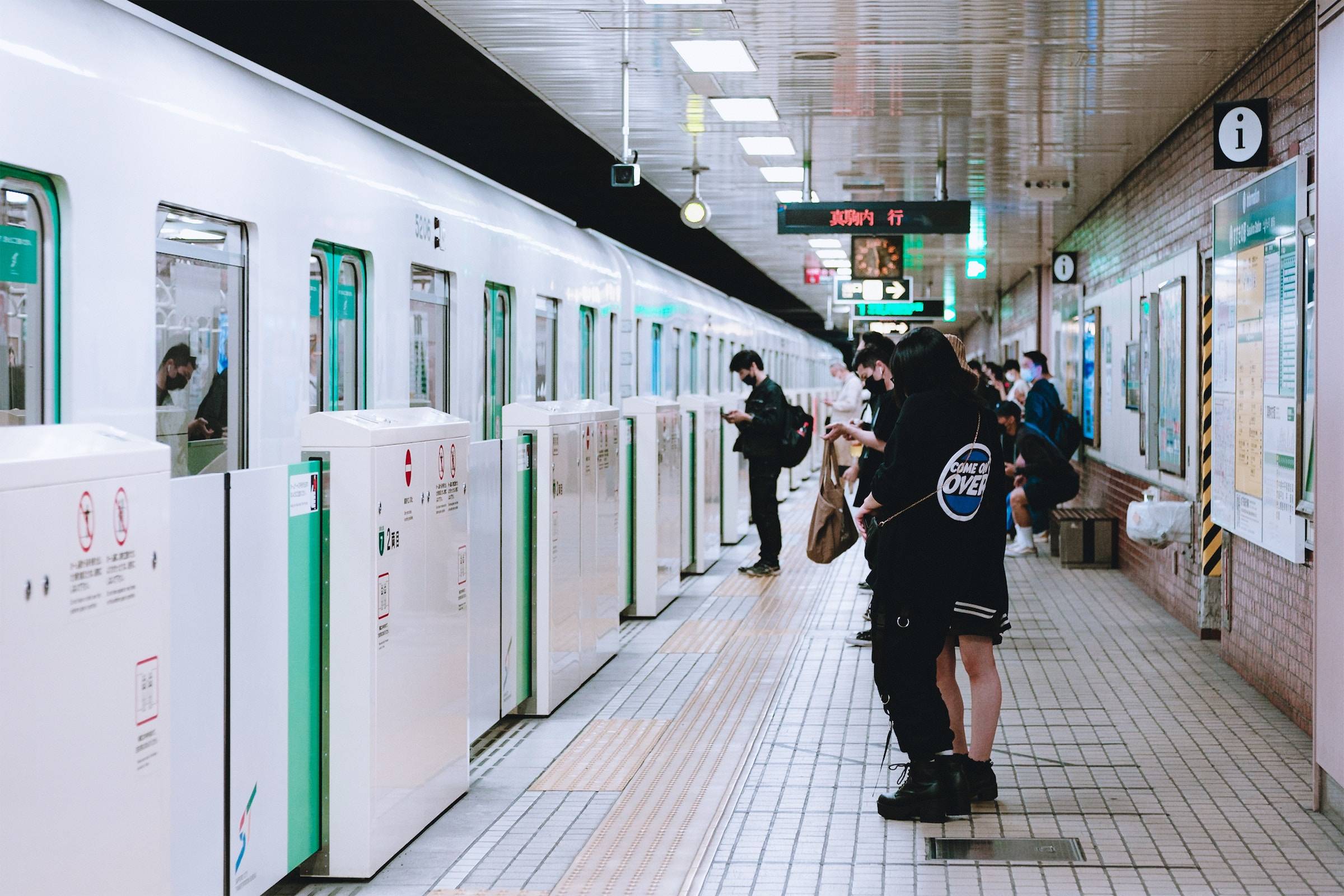
Other train (or train-like!) services that you may find yourself using during your time in Hokkaido are subway services in Sapporo. Also in Sapporo as well as Hakodate is a network of handy-dandy trams linking many of the city’s key sights and major hubs. Tickets are easily purchased at subway stations or train stations within these cities, and you can also use “IC Cards” (see the section below!) on some of these subway and tram lines.
Finally, if you are a train enthusiast, JR Hokkaido has a number of seasonal or special trains for you to enjoy, such as the open-air Furano-Biei “Norokko” train running on the JR Furano Line during summer or the “Fuyu no Shitsugen” steam train passing through the Kushiro wetlands in winter. These trains keep a slower pace than most other trains on the line, as rather than connecting two places, they are instead designed to give passengers a memorable and enjoyable ride.
As you may imagine, these special trains are in high demand and therefore all seating is reserved. As such, tickets can only be purchased in advance from ticket offices.
How to Buy a Train Ticket? #
The situation changes depending on trains, as well as whether or not your boarding or destination station is manned. As no two trains are the same in Hokkaido, we have created a handy series of PDFs for you to download and reference as needed!
How to Ride a Train #
Conveniently, trains on a certain route in Japan are always assigned to the same platform. This means that all you need to do is find the platform for your train and head there.
Larger stations, such as Sapporo or Asahikawa, will often have markings on the train platforms for limited express trains (and sometimes rapid trains) to help you find your seat. The markings will denote where the non-reserved and reserved seating carriages are, the carriage number, where the doors of the carriage will be and a guide to seating numbers closest to that particular door! This makes lining up to catch your train very easy indeed, and will also mean you don’t have to walk through several carriages to find your seat.
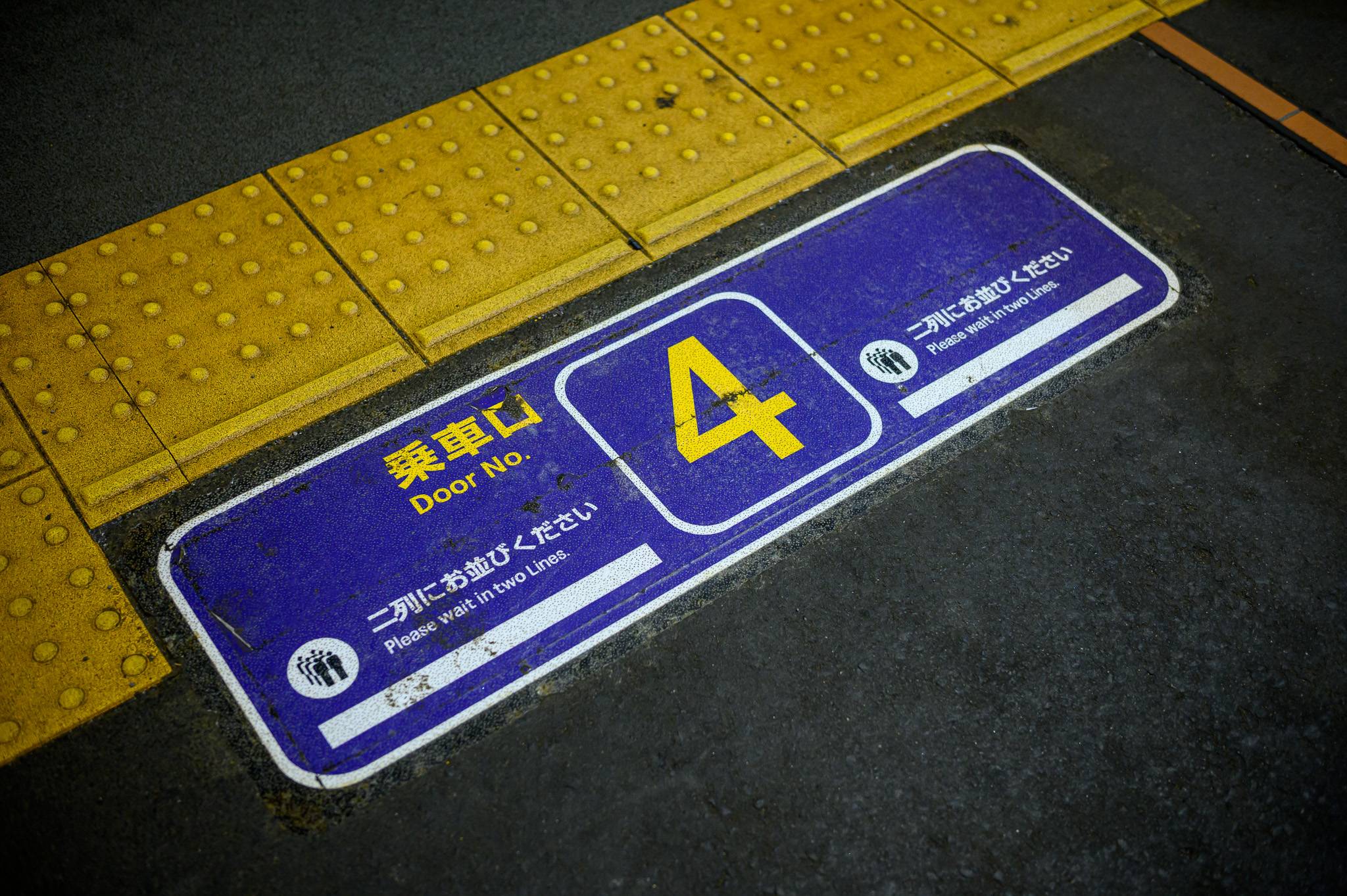
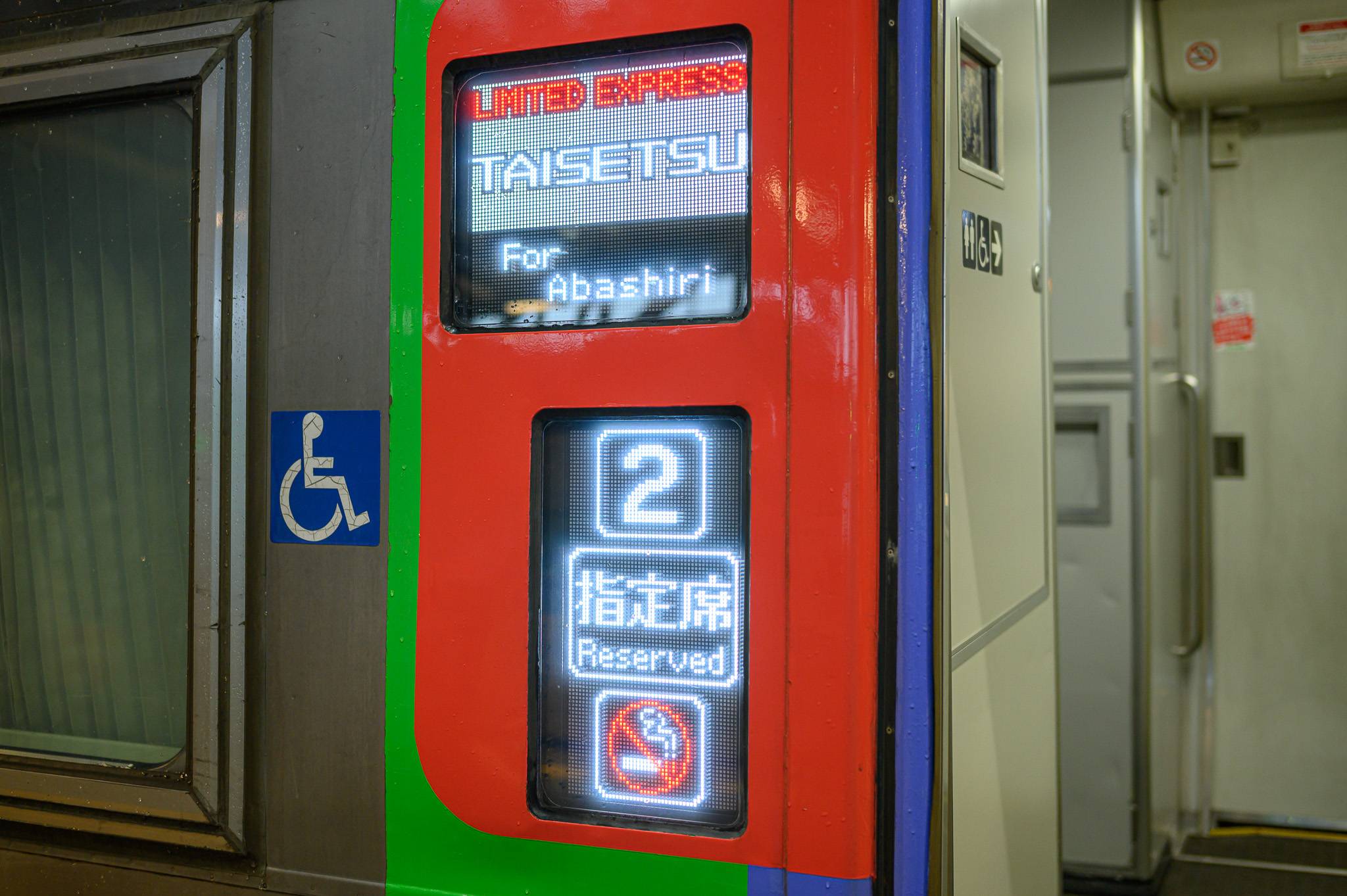
Smaller stations or local trains may not have any such markings, however, and you will just need to wait for the train to arrive and board from any of the open doors. Be aware that at some rural stations, the train may not stop in the middle of the platform but much further down at either end. One-man trains may also only open one door, usually the first door, for ticketing purposes.
Once you’ve boarded, find your assigned seat or an available seat and make yourself comfortable. Then, enjoy the ride!
The Challenges of Travelling by Train #
As Hokkaido residents rely increasingly on cars, train lines and stations across the region are disappearing or seeing less and less users. It is becoming not financially viable for Japan Rail to maintain many of Hokkaido’s train lines with so few passengers and with this comes budget cuts. These manifest most commonly in unmanned stations and reduced departures. This is not just a challenge for visitors from overseas but for Japanese visitors too, many of whom hail from large cities and are used to regular departures on busy lines!
The below are a few points to keep in mind as you traverse Hokkaido by train.
IC Cards May Not Be Accepted
IC Cards, credit card-sized travel passes that can be charged with money, are very common across much of mainland Japan. If you purchased a Suica IC card or similar in Tokyo, you may have found yourself relying on it quite a lot prior to arriving in Hokkaido. You can continue to use it on public transport across a lot of the wider Sapporo area and Hakodate’s popular trams.
However, outside of Sapporo, you will find that IC cards are not accepted on the majority of public transport. Once you leave Hokkaido’s capital, assume you will need to pay for fare tickets in cash when using public transport.
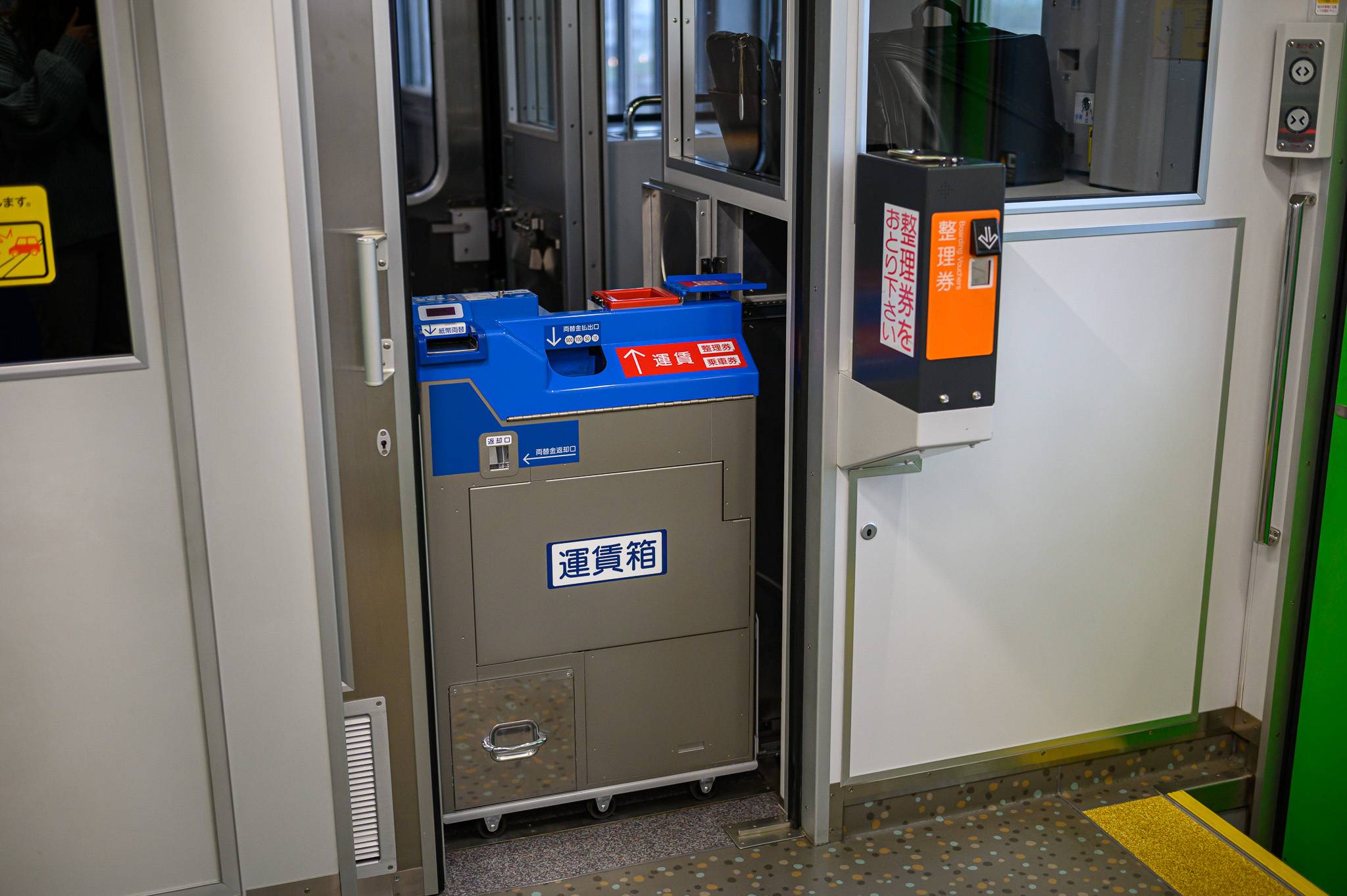
In addition, it is important to remember that even when departing from Sapporo, IC cards cannot be used on limited express trains! You must purchase a fare ticket and a special “limited express ticket” to ride these trains.
Infrequent Departures
It is not unusual along rural train lines for departures to be limited to only a handful of times a day… maybe even once or twice a day! This can create some logistical challenges if you have to be somewhere by a certain time. Keep an eye on your watch and make sure you don’t miss your scheduled departure… you might have to wait hours before the next one!
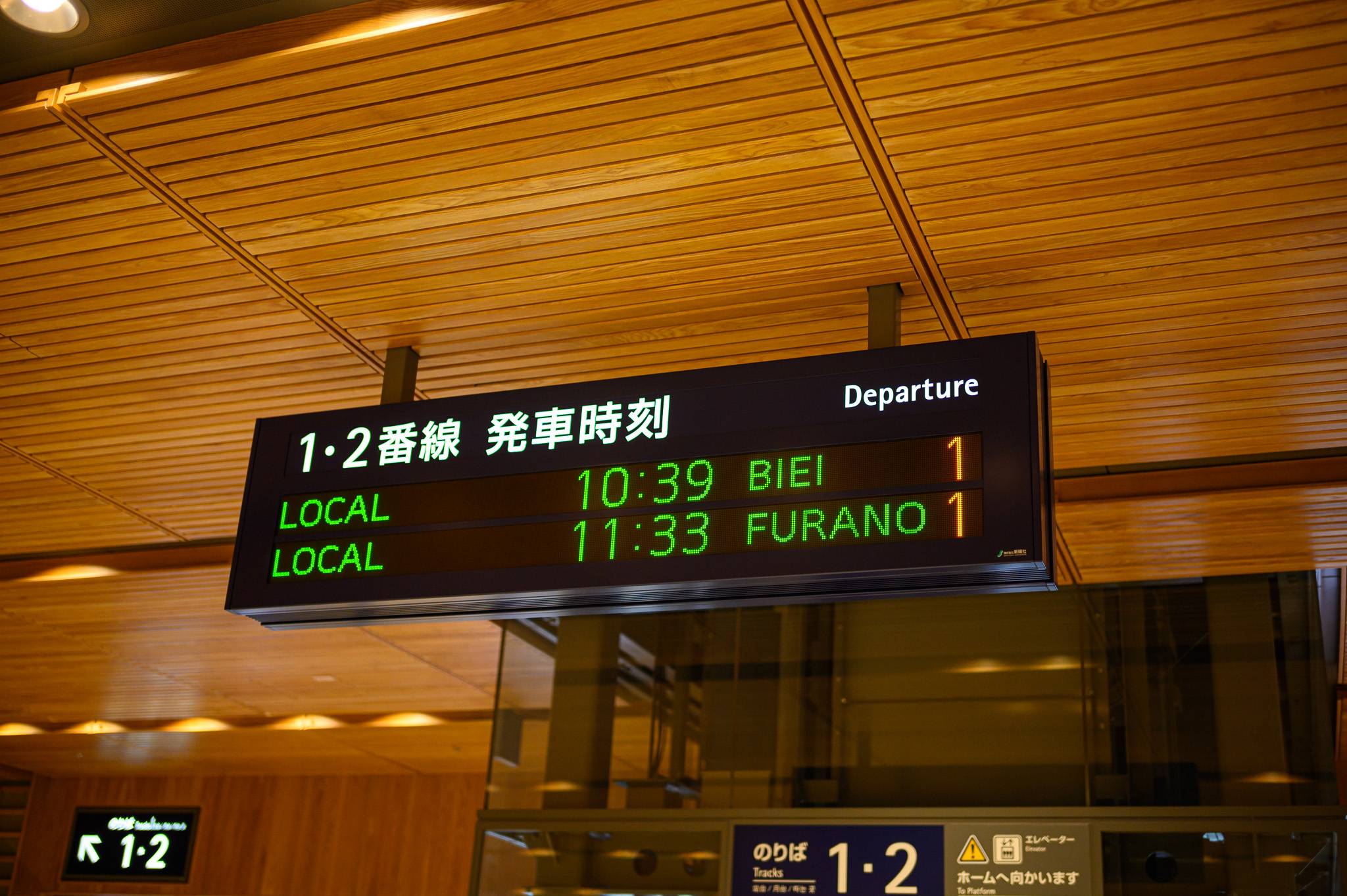
Delays Due to Weather (and Wildlife!)
Although Hokkaido is used to snow, there are times when even in this northern land blizzards can be so thick and strong as to make operating trains dangerous. When travelling by train in Hokkaido’s winter, you should always account for unexpected weather-related line suspensions and make a back-up plan, such as highway buses, to pull out of your bag of tricks when, well, snow hits the fan…

Hokkaido is also a land rich in wildlife and while this is of course a wonderful thing, year-round, there is also the chance that wildlife appearing on the tracks can shut down an entire trainline! Regular culprits are deer and in the summer, bears. Again, make sure you have a back-up plan at the ready in case of such occasions.
Unmanned Stations
As budgets are cut, so too are staff. This has resulted in a number of stations along JR Hokkaido lines where staff presence is limited to certain hours of the day, certain times of the year or is simply non-existent.
This may make you wonder how you pay for a ticket or get off a train at such stations. Check our “How to Buy a Ticket (Local & Rapid Trains)” PDF for more!
Staff May Not Speak English
Of course, no staff presence at a station means you can’t ask anyone for help at all, but you may find that at many stations across Hokkaido, station staff that are there may not speak English. However, if you come armed with information on a smartphone screen or print-out, then you should be able to make yourself understood!
Buses #
As with trains, buses in Hokkaido are disappearing as cars begin to take over. With that being said, they remain a handy way to get around urbanised areas and into some of the more far-flung corners of Hokkaido. And just like trains, some of them take you through spectacular areas which offer amazing views!
Types of Buses #
Fortunately, there are far less buses than trains to remember! Generally speaking, buses in Hokkaido are split into quite simple categories.
Local Buses
Example: Dohoku Bus serving Asahikawa Area, Shari Bus serving Shiretoko Peninsula

In urban areas, local buses are commonly used by the elderly and students making their way around cities. They also serve areas where train lines have now disappeared (these services are sometimes called “replacement buses”). Buses also continue to serve the Hokkaido countryside where it is not possible to construct train lines. They provide a vital link to the city for rural residents.
Within Sapporo, it may be possible to use IC cards on local buses. Outside of Sapporo, however, you will almost certainly need to pay for the fare in cash (check the “How to Buy a Ticket (Local Buses)” PDF).
Highway Buses & Night Buses
Example: Starlight Kushiro highway bus connecting Sapporo and Kushiro, Eagle Liner connecting Sapporo and Shiretoko
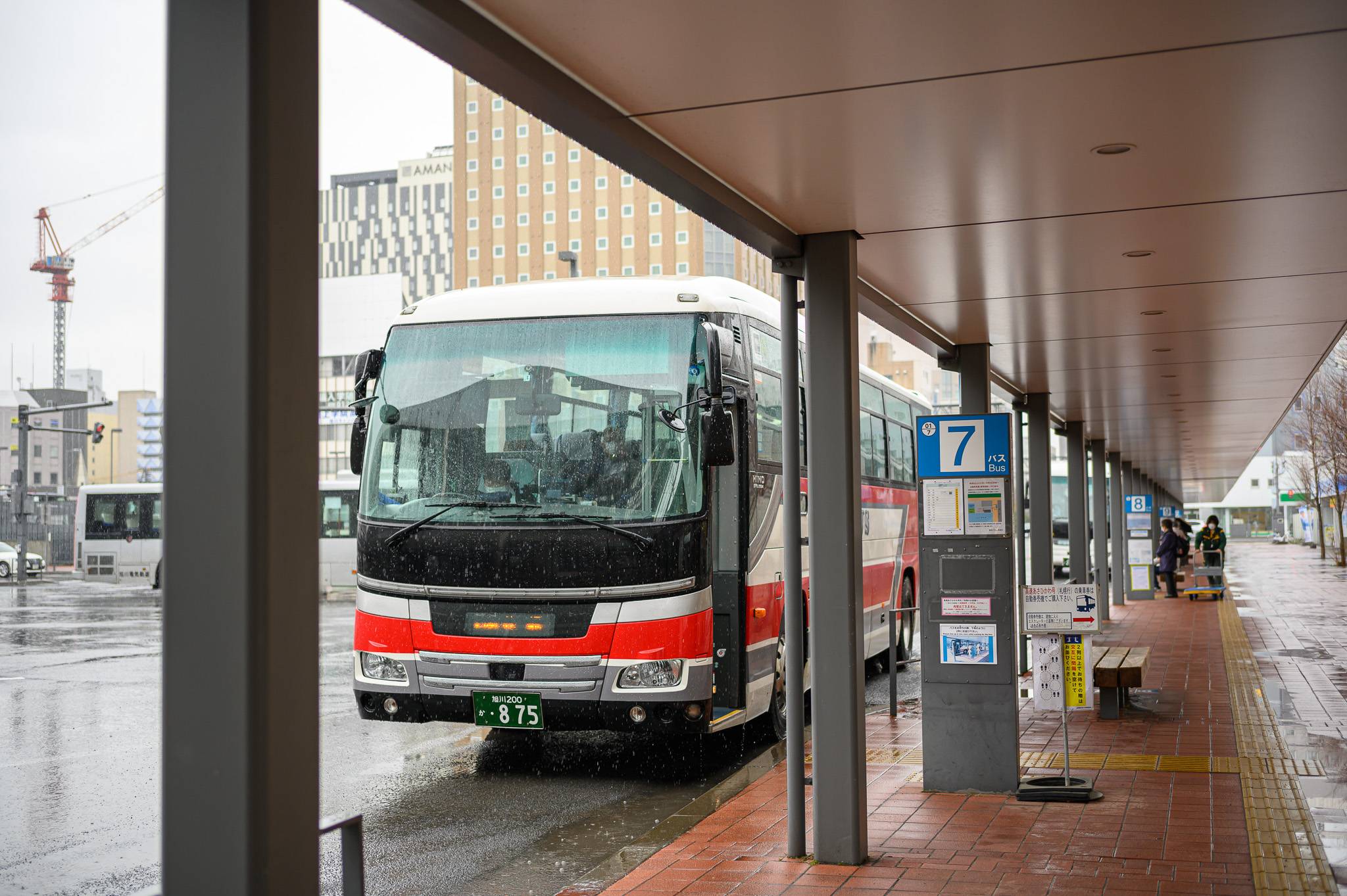
Highway buses (“kousoku bus” in Japanese) or night buses (“yakkou bus” in Japanese) are large coaches that take Hokkaido’s speedy highways to cross the region. They occasionally stop at rural areas not served by trains, making them quite popular among locals hoping to visit relatives in other parts of Hokkaido.
Some of these journeys can take eight hours or longer, and in these cases, the buses tend to operate through the night, giving travellers the freedom to sleep on board.
Highway buses and night buses have, of late, become quite a popular way among young people to explore Hokkaido. Cost-wise, they are often more competitive than the train and the time they take to cross Hokkaido is often not that much longer. Night buses also provide the benefit of not losing a day to cross-regional travel. In addition, there is no need to make any changes during the journey. Some highway buses also have WiFi and toilets, and often stop for breaks at Japan’s entertaining “Michi-no-Eki” roadside stations. All you need to do is sit back and relax!
Airport Buses
Example: Lavender-Gou between Asahikawa Airport and Furano, Airport Liner between Sapporo and New Chitose Airport

Airport buses are a handy and cost-effective way to get to the airport, especially for provincial airports which may not be served by local train lines. It is possible to purchase tickets in advance for some buses, but for many of them the process is the same as local buses. Check the “How to buy a Ticket (Airport Bus)” PDF for more information.
Other Buses
Example: Complimentary hotel shuttle buses, sightseeing shuttle buses
Japan prides itself on its “omotenashi” culture, the culture of making visitors feel welcome and making life as easy for them as possible. As part of this, it’s not unusual for hotels to offer complimentary shuttle bus services to and from stations or airports, or even to sightseeing spots of interest in their town. While this service is free, bear in mind it is only available to guests of the hotel and may only operate in limited seasons or at certain times of the day.
Similarly, some towns may offer shuttle buses between local stations and popular sightseeing spots during peak seasons. These may or may not require a fee, depending on the attraction.
How to Buy a Bus Ticket #
Generally, bus fares in Hokkaido are purchased in one of two ways. For longer-distance buses (highway and night buses) and some airport buses in more populated areas, you will need to purchase the bus ticket in advance.
For local buses and provincial airport buses, you will have to purchase the fare upon boarding the bus by taking a numbered ticket.
Check our handy PDF guide below for the full how-to!
Download How to Buy a Ticket (Buses)
How to Ride a Bus #
Where you get on the bus depends on whether you purchase a ticket on board (for local buses and provincial airport buses) or have bought one in advance (highway and night buses, and airport buses heading to larger airports). If you have bought a ticket in advance, you will be asked to board via the front door after depositing your luggage to be put in the hold. The driver will check the details of your ticket before allowing you on the bus.
For local buses or airport buses where advance purchase is not possible, as per the PDF, you must board the bus from the rear door and take a numbered ticket from the machine by the door (or, in Sapporo, touch your IC card to the reader). This ticket will denote the fare you’ll pay later on.
When getting off an advance-purchase bus, there is nothing more you need to do! Don’t forget to thank your driver with a quick “arigato” and remember to collect any luggage that was stored in the bus’s hold.
When disembarking an on-the-day purchase bus, you must exit via the front door and pay the fare as displayed on the bus’s fare board. Keep in mind that the fare must be paid in exact change only, although there usually is a change dispenser next to the fare machine. If you used an IC Card to board the bus, all you have to do is touch out when disembarking.
The Challenges of Travelling by Bus #
As with travelling by train, there are a few points to keep in mind when crossing Hokkaido by bus. Some of these challenges are similar to those faced when travelling by train.
IC Cards May Not Be Accepted
As outlined above, outside of Sapporo it is unlikely that you will be able to use IC cards on buses, including buses heading to airports. It is also not possible to use IC cards to purchase tickets for highway or night buses.
Exact Change Only
Bus drivers cannot give you change, meaning you must pay for the fare on local buses with exact change only. Make sure you’ve got plenty of coins with you for your journey. If you do not have enough, then keep a few 1000yen notes handy. Buses often have change dispensers that can split 1000yen notes up into coins of various denominations (100yen, 50yen, 10yen etc).
Infrequent Departures
As with trains, buses in rural areas of Hokkaido do not come often. If you miss your departure, you could well find yourself stranded! Make sure you are at the bus stop on time, ready to board.
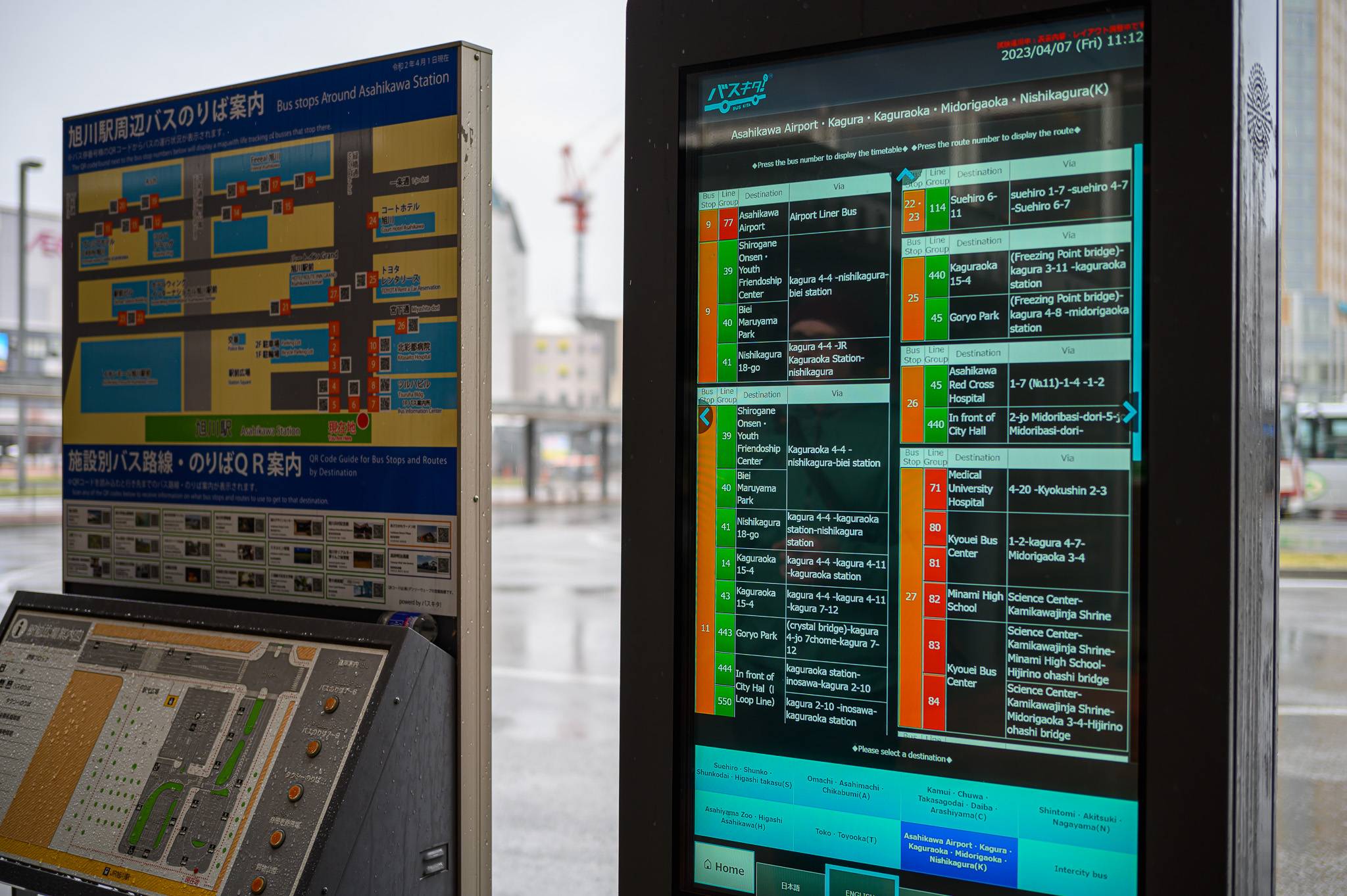
On the plus side, sometimes buses in Japan do run a little ahead of schedule. In this event, the driver will not skip the stop as they might do in other countries. They will politely wait at the bus stop until the scheduled departure time. This is quite nice in winter, as you get to wait on a nice warm bus instead of out in the cold!
Delays
Weather can cause delays to buses as they do trains, but as the roads in Hokkaido are more frequently cleared of snow compared to the rails, buses generally continue to run in conditions that would bring trains to a halt.
More likely are traffic delays, especially if your bus is crossing through an urban area before heading into a more rural one. If your bus is delayed, don’t assume you have missed it– stick around at the bus stop until it arrives. If you’re delayed enroute, make sure you’ve got a back-up plan ready to go for when you get off the bus!
Silence on Board
You may find the environment of buses is a little more strict than that of trains, where the loud sound of the train engine may mask a lot of background noise. While talking at a low volume on buses is acceptable, talking on the phone or talking in raised voices is considered quite rude and a nuisance to other passengers. Even excess noise from your headphones is frowned upon! The silence on buses in Japan is quite noticeable compared to buses overseas.
Ferries #
There are many small islands off Hokkaido’s coast, and a ferry is the best – often only – way to visit them. Seeing the coastline from the sea is often a highlight in itself, as is spotting our marine animals in their natural habitat.
Types of Ferries #
While every boat and service is different, Hokkaido’s ferries are split into 3 main categories depending on their primary use:
Passenger & Car Ferries
Example: Heartland Ferry to Rishiri and Rebun islands from Wakkanai
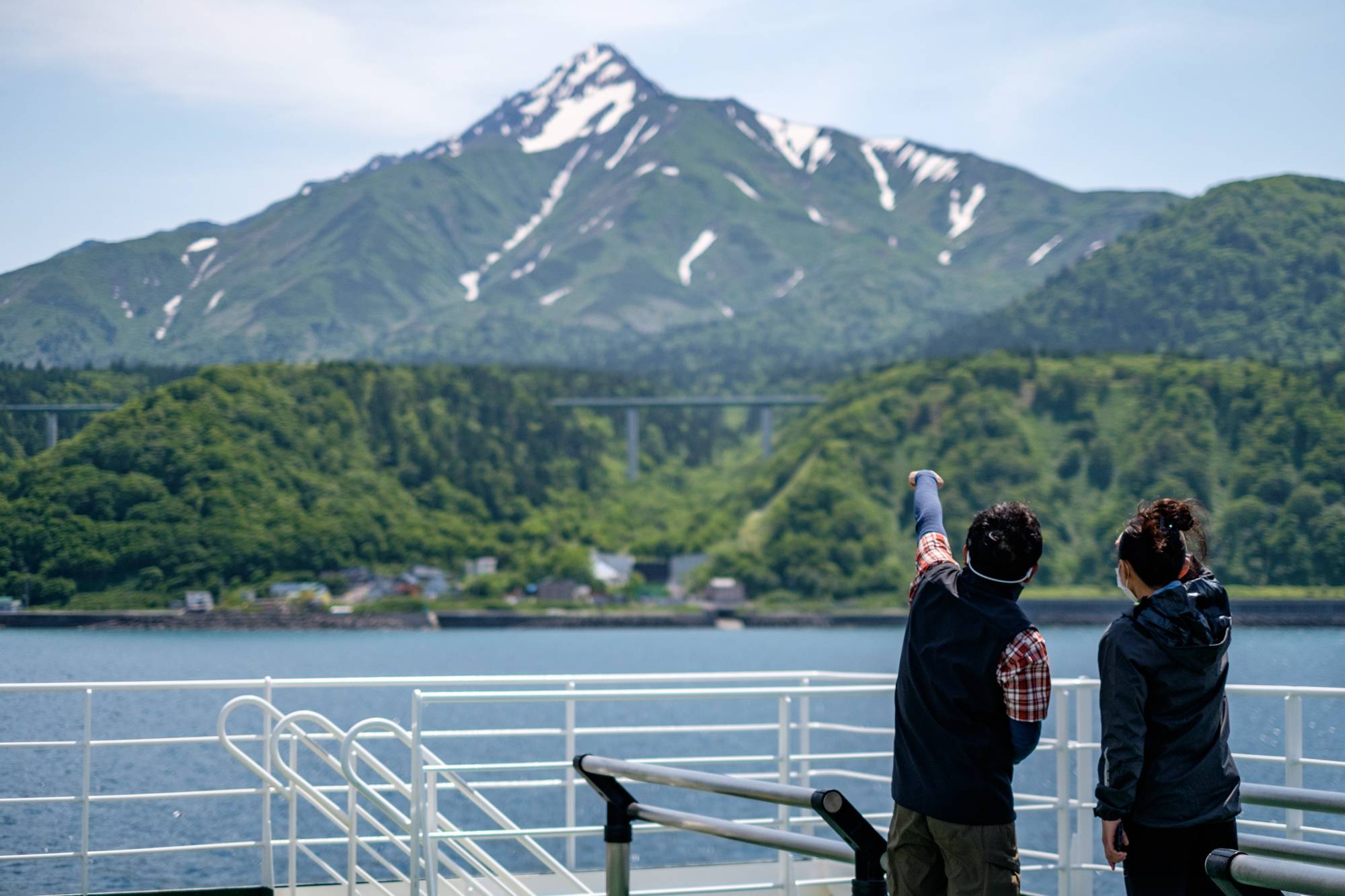
The ferries to Hokkaido’s outer islands are first and foremost the link between the island communities and mainland Hokkaido. As such, most carry both cars and foot passengers.
These ferries will have inside seating and carpet areas to lie down in. They usually have more deck space than other ferry types, so you can find a nice spot outdoors to enjoy the sea air.
As the costs are subsidised by freight transport, the passenger fares are often lower than other ferries. However, expect to pay significantly more if you are taking a car.
Passenger Ferries
Example: The high speed Sunliner 2 ferry to Okushiri and Teuri islands from Haboro
Some routes also have smaller – and faster – passenger ferries. They will get you to your destination quicker but expect to pay about twice as much as the combined passenger and car ferries.
Sightseeing Cruises
Example: Shiretoko Nature Cruise in Rausu
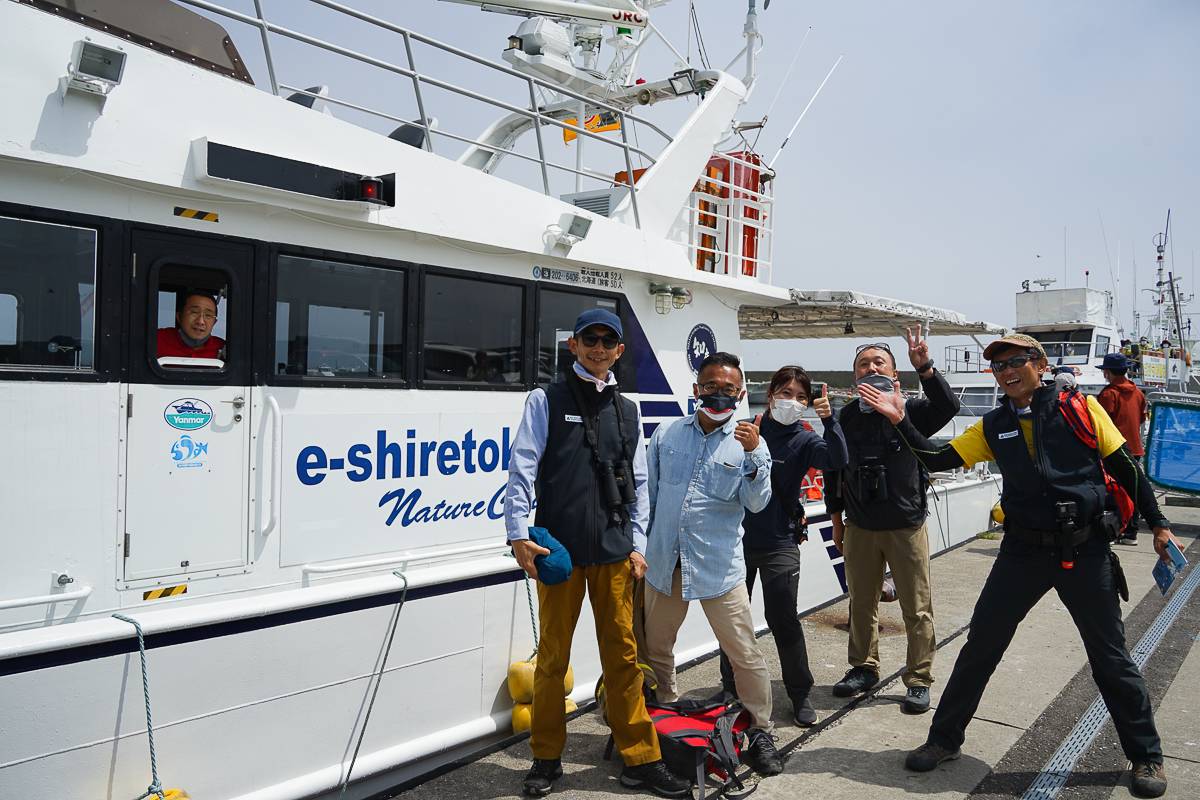
Taking a sightseeing cruise is a great way to see a different side of Hokkaido’s coastline. In places such as Shiretoko, they allow you to see marine wildlife up close or search for bears along the rocky coast.
These cruises will usually start and finish in the same port. The boats usually have a raised outside viewing deck as well as indoor seating. It is common to be asked to wear a life jacket while onboard the cruise.
How to Buy a Ferry Ticket #
Sightseeing cruises require booking in advance, often months in advance during peak season. For regular passenger ferries booking in advance isn’t necessary and you can purchase your ticket from the ticket counter when you arrive at the port. Many ferries have English-speaking staff, but if not there are only 1 or 2 destination options, so it’s hard to go wrong.
Taking a car on the ferry is a bit more complicated – you will need to provide details on the type and size of the car and often present the shaken inspection document.
How to Board a Ferry #
For combined passenger and car ferries, you will board from the second floor of the terminal. Head upstairs once you have your ticket and wait for the boarding gate to open. Once the ferry is ready for boarding you will scan your ticket and cross over the ferry via a covered gangway.
Once on board, find yourself a good seat and settle in for the ride. The majority of indoor seating is on carpeted floors, don’t forget to take off your shoes before stepping on the carpet. If you’re not comfortable on the floor you can also find limited seats on most ferries. Outside of first-class seating, there are no reserved seats.

You can also head outside as long as the conditions aren’t too rough. Taking in the sight of Mt Rishiri from the ferry is one of my favourite parts of visiting the island, and I often see porpoises and sea birds during the crossing. I highly recommend spending your time outside if the weather is nice. However, you will find most locals asleep inside!
As with buying tickets, boarding with a vehicle requires a few more steps. However, there is plenty of staff on hand to direct you throughout the process and hand gestures transcend the language barrier. One thing to note however is that only the driver can be in the car, all other passengers board the ferry on foot.
The Challenges of Travelling by Ferry #
Adding the unpredictable ocean into the equation does bring a few challenges when travelling by ferry in Hokkaido:
Seasickness
The bane of many ferry journeys. Sadly it is rare for the sea to be as smooth as the roads or rails, so expect to be rocked during your trip. This is especially common on the Rishiri & Rebun ferries after a strong southerly wind as the waves hit the boat side on. We recommend taking seasickness medication before you travel. Seasickness is another reason to spend your time outside – if you can see the horizon it makes it much easier for your brain to process the movement. Also, avoid the top decks as they sway the most.
Cancelation due to the weather
Your travel plans are ultimately at the mercy of the sea. Ferry and cruise operators will cancel their sailings if conditions are unsafe, the accident in Shiretoko in 2022 was a tragic reminder of the consequences of getting it wrong.
If you are visiting one of our islands, we recommend you leave a day or two between catching the ferry back and any international flights. If there is bad weather forecast, chat with a local as they will know best what the risk of the ferry being cancelled is.
For most sightseeing cruises, you will need to check in the day before to confirm if the cruise will go ahead.
Infrequent Departures
There will only be a few crossings each day – sometimes only one. Also, unlike the bus or train, there is no taxi service as a backup if you miss the ferry. Your only option is to stay an extra night and catch the ferry the next day.
Are You Ready for Your Public Transport Adventure?
Travelling across Hokkaido by public transport is not without its challenges, but it is certainly not impossible. In fact, once you get used to it, it is really quite enjoyable!
It also offers a number of benefits over travelling by rental car, such as being more planet-friendly and safer. Plus, as you won’t be concentrating on the road, you have the chance to relax and enjoy some wonderful views!
And I speak from a great deal of experience– for many years, I have lived car-free by choice in Hokkaido! Those around me have often worried that it must cause me an inconvenience, but on the whole, I can honestly say my day-to-day life and my travels across Hokkaido have been relatively unaffected by being car-less. All it takes is a little forward-planning, some careful time management and the occasional back-up plan.
If I can do it, so can you! So enjoy the ride and the wonderful views, and have a fantastic public transport adventure around Hokkaido!
Take a look at our Self-Guided Tours!
Explore Hokkaido under your own steam. Check out our full list of Self-Guided Tours!